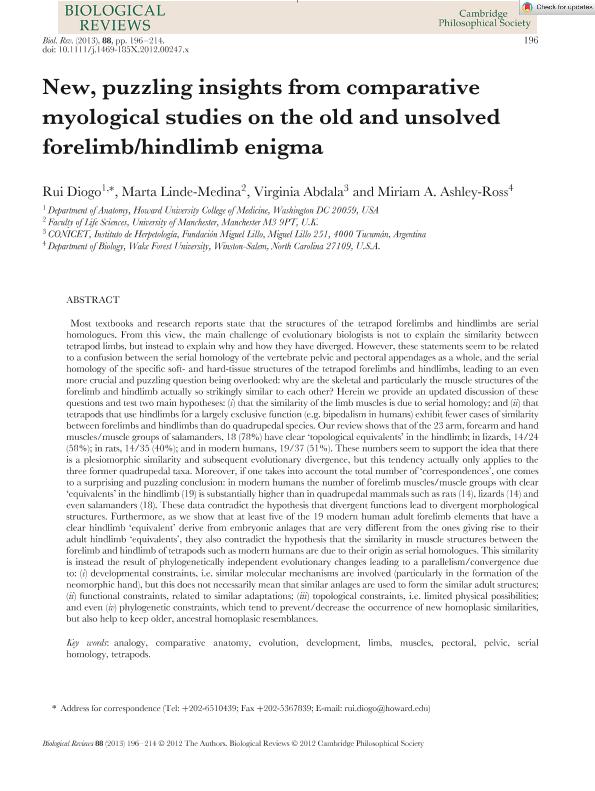Mostrar el registro sencillo del ítem
dc.contributor.author
Diogo, Rui
dc.contributor.author
Linde Medina, Marta
dc.contributor.author
Abdala, Virginia Sara Luz

dc.contributor.author
Ashley Ross, Miriam A.
dc.date.available
2017-10-11T14:04:06Z
dc.date.issued
2012-09
dc.identifier.citation
Diogo, Rui; Linde Medina, Marta; Abdala, Virginia Sara Luz; Ashley Ross, Miriam A.; New, puzzling insights from comparative myological studies on the old and unsolved forelimb/hindlimb enigma; Wiley; Biological Reviews; 88; 1; 9-2012; 196-214
dc.identifier.issn
1464-7931
dc.identifier.uri
http://hdl.handle.net/11336/26437
dc.description.abstract
Most textbooks and research reports state that the structures of the tetrapod forelimbs and hindlimbs are serial homologues. From this view, the main challenge of evolutionary biologists is not to explain the similarity between tetrapod limbs, but instead to explain why and how they have diverged. However, these statements seem to be related to a confusion between the serial homology of the vertebrate pelvic and pectoral appendages as a whole, and the serial homology of the specific soft- and hard-tissue structures of the tetrapod forelimbs and hindlimbs, leading to an even more crucial and puzzling question being overlooked: why are the skeletal and particularly the muscle structures of the forelimb and hindlimb actually so strikingly similar to each other? Herein we provide an updated discussion of these questions and test two main hypotheses: (i) that the similarity of the limb muscles is due to serial homology; and (ii) that tetrapods that use hindlimbs for a largely exclusive function (e.g. bipedalism in humans) exhibit fewer cases of similarity between forelimbs and hindlimbs than do quadrupedal species. Our review shows that of the 23 arm, forearm and hand muscles/muscle groups of salamanders, 18 (78%) have clear ‘topological equivalents' in the hindlimb; in lizards, 14/24 (58%); in rats, 14/35 (40%); and in modern humans, 19/37 (51%). These numbers seem to support the idea that there is a plesiomorphic similarity and subsequent evolutionary divergence, but this tendency actually only applies to the three former quadrupedal taxa. Moreover, if one takes into account the total number of ‘correspondences’, one comes to a surprising and puzzling conclusion: in modern humans the number of forelimb muscles/muscle groups with clear ‘equivalents’ in the hindlimb (19) is substantially higher than in quadrupedal mammals such as rats (14), lizards (14) and even salamanders (18). These data contradict the hypothesis that divergent functions lead to divergent morphological structures. Furthermore, as we show that at least five of the 19 modern human adult forelimb elements that have a clear hindlimb ‘equivalent’ derive from embryonic anlages that are very different from the ones giving rise to their adult hindlimb ‘equivalents’, they also contradict the hypothesis that the similarity in muscle structures between the forelimb and hindlimb of tetrapods such as modern humans are due to their origin as serial homologues. This similarity is instead the result of phylogenetically independent evolutionary changes leading to a parallelism/convergence due to: (i) developmental constraints, i.e. similar molecular mechanisms are involved (particularly in the formation of the neomorphic hand), but this does not necessarily mean that similar anlages are used to form the similar adult structures; (ii) functional constraints, related to similar adaptations; (iii) topological constraints, i.e. limited physical possibilities; and even (iv) phylogenetic constraints, which tend to prevent/decrease the occurrence of new homoplasic similarities, but also help to keep older, ancestral homoplasic resemblances.
dc.format
application/pdf
dc.language.iso
eng
dc.publisher
Wiley

dc.rights
info:eu-repo/semantics/openAccess
dc.rights.uri
https://creativecommons.org/licenses/by-nc-sa/2.5/ar/
dc.subject
Comparative Anatomy
dc.subject
Development
dc.subject
Muscles
dc.subject
Limbs
dc.subject.classification
Bioquímica y Biología Molecular

dc.subject.classification
Ciencias Biológicas

dc.subject.classification
CIENCIAS NATURALES Y EXACTAS

dc.title
New, puzzling insights from comparative myological studies on the old and unsolved forelimb/hindlimb enigma
dc.type
info:eu-repo/semantics/article
dc.type
info:ar-repo/semantics/artículo
dc.type
info:eu-repo/semantics/publishedVersion
dc.date.updated
2017-08-25T19:53:19Z
dc.journal.volume
88
dc.journal.number
1
dc.journal.pagination
196-214
dc.journal.pais
Estados Unidos

dc.journal.ciudad
Hoboken
dc.description.fil
Fil: Diogo, Rui. Howard University College of Medicine; Estados Unidos
dc.description.fil
Fil: Linde Medina, Marta. University of Manchester; Reino Unido
dc.description.fil
Fil: Abdala, Virginia Sara Luz. Fundación Miguel Lillo. Dirección de Zoología. Instituto de Herpetología; Argentina. Consejo Nacional de Investigaciones Científicas y Técnicas; Argentina
dc.description.fil
Fil: Ashley Ross, Miriam A.. University Wake Forest; Estados Unidos
dc.journal.title
Biological Reviews

dc.relation.alternativeid
info:eu-repo/semantics/altIdentifier/doi/http://dx.doi.org/10.1111/j.1469-185X.2012.00247.x
dc.relation.alternativeid
info:eu-repo/semantics/altIdentifier/url/http://onlinelibrary.wiley.com/doi/10.1111/j.1469-185X.2012.00247.x/abstract
Archivos asociados
